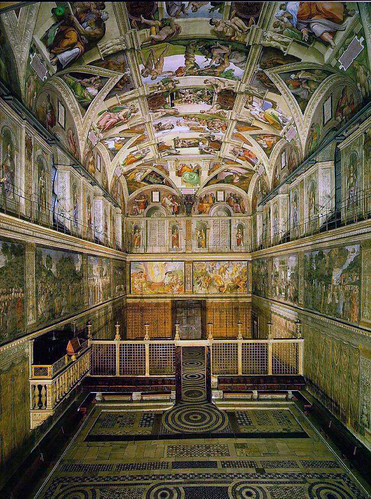Pope Sixtus IV consecrates the Sistine Chapel.
Tag Archives: 1483
15 August 1483
The Sistine Chapel is consecrated by Pope Sixtus IV.
The Sistine Chapel is a chapel in the Apostolic Palace, the official residence of the Pope, in Vatican City. Originally known as the Cappella Magna, the chapel takes its name from Pope Sixtus IV, who restored it between 1477 and 1480. Since that time, the chapel has served as a place of both religious and functionary papal activity. Today it is the site of the Papal conclave, the process by which a new pope is selected. The fame of the Sistine Chapel lies mainly in the frescos that decorate the interior, and most particularly the Sistine Chapel ceiling and The Last Judgment by Michelangelo.
During the reign of Sixtus IV, a team of Renaissance painters that included Sandro Botticelli, Pietro Perugino, Pinturicchio, Domenico Ghirlandaio and Cosimo Roselli, created a series of frescos depicting the Life of Moses and the Life of Christ. These paintings were completed in 1482, and on 15 August 1483 Sixtus IV celebrated the first mass in the Sistine Chapel for the Feast of the Assumption, at which ceremony the chapel was consecrated and dedicated to the Virgin Mary.
Between 1508 and 1512, under the patronage of Pope Julius II, Michelangelo painted the chapel’s ceiling, a project which changed the course of Western art and is regarded as one of the major artistic accomplishments of human civilization. In a different climate after the Sack of Rome, he returned and between 1535 and 1541, painted The Last Judgment for Popes Clement VII and Paul III. The fame of Michelangelo’s paintings has drawn multitudes of visitors to the chapel ever since they were revealed five hundred years ago.
6 July 1483
Richard III is crowned the King of England.
Richard III, also called Richard Plantagenet, duke of Gloucester, born October 2, 1452, Fotheringhay Castle, Northamptonshire, England—died August 22, 1485, near Market Bosworth, Leicestershire, the last Plantagenet and Yorkist king of England. He usurped the throne of his nephew Edward V in 1483 and perished in defeat to Henry Tudor at the Battle of Bosworth Field. For almost 500 years after his death, he was generally depicted as the worst and most wicked of kings. Some of those charges are now regarded as excessive, the work of his enemies, and his supporters have attempted to rehabilitate him. Modern scholars take a more-balanced approach that avoids the extremes of either side.
Richard III presented himself as a reformer committed to justice and morality who would remedy the supposed misrule of Edward IV’s last years and the sexual license of his brother’s court. His signet registers reveal plans to improve the management of the royal estates and the north. He also came to an agreement with Queen Elizabeth and the Wydevilles. She accepted him as king, and he allowed her and her daughters to emerge from sanctuary and provided for them. Unfortunately, his good intentions could not be implemented in a reign of only two years or in the face of serious opposition.
15 August 1483
Pope Sixtus IV consecrates the Sistine Chapel.
15 August 1483
The Sistine Chapel is consecrated by Pope Sixtus IV.


